
Search myodfw.com


Hunting involves a deadly weapon that can kill more than just your target. Hunting and handling your gun safely MUST be a top priority. Start with the fundamentals Start by learning these four gun safety fundamentals and you’ll be well on you way to a lifetime of safe hunting. Assume all guns are always loaded. The primary benefit of handling all guns as if they were loaded, is that it will help you develop safe gun handling habits. Never let the muzzle of the gun (the shooting end) point at something you’re not willing to shoot. Often referred to as

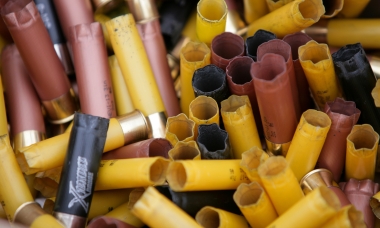
There are fundamental differences between turkey hunting with a bow and a shotgun, including effective range, shot placement and set up. Effective shooting distance Your effective shooting distance (how far you can be from a turkey and likely kill it with a single shot) will vary with the level of your shooting skills and the type of equipment you’re using. A good rule of thumb for shotgun shooters is 40 yards. Anything further than that and there’s a good chance you might not hit the head and neck with enough pellets to kill the bird. Any closer than 20 yards

The modern compound bow is the most popular choice for turkey hunting, but traditional recurve and longbows also have their fans. Hunting with crossbows is illegal in Oregon. If you already have a bow you use for deer or elk hunting, it will work fine for turkey Many turkey hunters, though, like to reduce the draw weight of their deer/elk hunting bow to 45 pounds or less for turkey. Unlike deer and elk hunting, where you’re usually standing or kneeling when you take a shot, you’re likely to be sitting when shooting a turkey. In this case, a lighter draw

There are many options when it comes to choosing arrows and broadheads for turkey hunting. If you already hunt big game, you can use the same arrow shafts for hunting turkey. If you’re new to bowhunting and buying arrows for the first time, select an arrow shaft made of a lightweight, fast-moving material like carbon fiber. An arrow that weighs about 6 to 8 grains per per pound of draw weight (on a compound bow) is a good guideline. This will maximize kinetic energy, accuracy and penetration. There are three styles of broadheads popular with turkey hunters: Expandable, or mechanical

Bowhunter education is not required to hunt during archery-only seasons in Oregon. However completing Oregon’s Bowhunter Education Program can make you a more versatile and successful bowhunter. In addition, several neighboring states do require bowhunter education. Bowhunters who are certified through Oregon’s Bowhunter Education Program will be qualified to hunt in all other states and Canadian Provinces. Students in the Oregon Bowhunter Education Program get an introduction to bowhunting, and learn more about wildlife conservation, safe and responsible bowhunting, the parts of a bow and arrow, how to prepare for a hunt, hunting techniques, shot placement, game recovery and outdoor
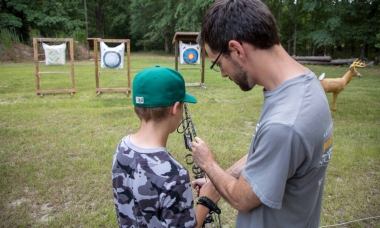

You don’t need a lot of gear to hunt turkey – that’s one reason for its growing popularity. However, the more you hunt – in different seasons and in different parts of the state – the more you’ll discover there are some things that can make you a more comfortable and successful hunter. Here are some essential pieces of gear beginning turkey hunters will want to consider: A face mask or camouflage face paint. Turkeys have keen eyesight so you’ll want to cover your entire face and neck with something camouflage that’s comfortable to wear. Bowhunters often prefer camo face

As with all types of hunting, it’s important to choose the right kind of clothing for turkey hunting. Early in the spring turkey season, conditions can be very cold and wet compared to later in the season. At the same time, higher elevations may be colder than the valley floors. The fall turkey hunting season also offers a wide-range of weather conditions, in a variety of places. The weather in October can be very different than conditions in late December. This means proper clothing is important no matter what time of year or where in the state you’re hunting. Layer

It’s hard to enjoy a day of hunting if your feet are cramped, wet or cold. Many turkey hunters in Oregon have at least two different pairs of boots to meet the variety of conditions they might encounter while hunting. Rubber boot for cold, wet conditions Rubber knee boots are a good choice when conditions are cold and wet, and/or when you’ll be sitting for hours in a ground blind. Many boots are insulated to help keep your feet warm. If you’re looking at uninsulated boots, buy them ½ to one size larger than you normally wear. This will give
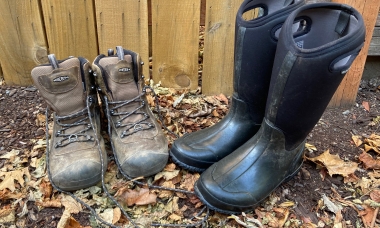
You’ll need a way to carry your shells, turkey calls, first aid kit, extra gloves, lunch, water and other gear into the field. The most popular choices are a daypack or a specialized turkey hunting vest. Daypacks are simple and affordable A daypack is a simple and affordable option. It will hold a lot of stuff, most have some pockets to help you organize your gear, and some are hydration bladder compatible to help you stay hydrated during hot, dry hunts. Keep these things in mind when packing a daypack: Make sure the things in your daypack are secure and
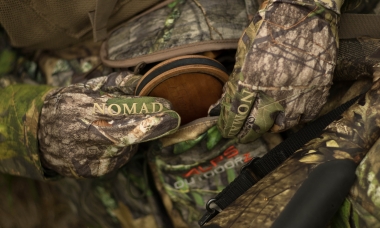
While turkey hunting is one of the safest forms of hunting, there are some safety tips hunters should follow. Be visible when you need to be The biggest risk in turkey hunting is being in the woods with other turkey hunters. Remember, everyone will be wearing camouflage and sounding like a turkey as they try to call in birds (including you). Therefore, you’ll want to make sure you and your location are visible while you’re walking to the blind or setting up, while you’re set up behind a tree and while you’re carrying your bird out of the field. A
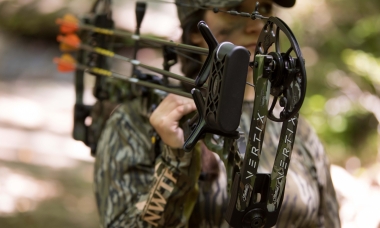

There are two steps in patterning your gun: Verify your point of impact. Confirm the pellets are hitting where you’re aiming. Often called sighting in. Check the pattern of the pellets to see what loads shoot most accurately. Often called patterning. Sight in scopes and fiber optic sites If you’re shooting a shotgun with a single bead on top of the barrel, you can go right to patterning. If you’re shooting a shotgun mounted with a scope or reflex sight, or a fiber optic front and rear site, you’ll need to sight in the gun before you pattern it. Start


Before shooting a bow, you’ll want to make sure it's safe to fire. Bow/arrow safety check list Check that the string and cable are in good condition and aren ’t rubbing or fraying at any point. Use bowstring wax regularly to keep your string in good condition and safe to shoot. Check that the cams, limbs and riser are all in good shape. Look for cracks, dents, breaks, delaminations, peeling fiberglass, and any mechanical parts that may be defective. If any part of the bow is suspect, don’t shoot it. Fix it or take it to an archery shop to

Practice shooting your bow regularly and you’ll develop the form and muscle memory you need to shoot accurately and confidently. Places to shoot from the backyard to the backcountry You can practice your shooting anywhere it’s safe and outside of urban growth boundaries. It's also illegal to shoot in the direction of any person, building, structure or vehicle within the range of your bow. So be sure there's y a clear line of sight between you and the target, and a safe backstop. Possible locations include: A large backyard in a rural setting Archery specific indoor and outdoor target ranges

